

Medieval Narrative: Backgrounds of Medieval Literature. The Carnival Spirit in Medieval Europe The social structures dominating life in medieval Europe drew attention to the figures on top of the hierarchical ladders --kings and popes, lords and ladies, chivalric heroes--and to the institutions they represented and sustained.

But since life at the bottom of the ladder exists as well, a remarkably vibrant counter-culture challenged the orthodox vision. Side by side with serious epic poems, for example, appeared mock epics, often in the form of beast fables whose talking animals ridicule or parody the highflown utterances of traditional heroes. On every great Gothic cathedral, next to exquisite stained glass windows and rows of statued saints, lurk grotesque gargoyles, twisted, shocking, and amusing figures that entwine animal and human forms.
Simply performing a necessary architectural function, these gargoyles drained water from the central strcture, but also commented ironically on the surrounding grandeur. Allegory Courtly Love Fortune 1. Medieval Narrative: Backgrounds of Medieval Literature. Chivalric romance. BritlitwithBeavers - Characteristics of Medieval Literature. Skip to main content Try Wikispaces Classroom now.
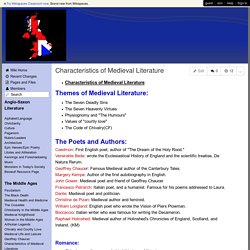
Brand new from Wikispaces. guest Join | Help | Sign In BritlitwithBeavers Home guest| Join | Help | Sign In Turn off "Getting Started" Loading... Medieval poetry. Because most of what we have was written down by clerics, much of extant medieval poetry is religious.
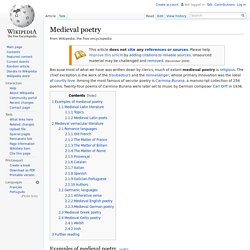
The chief exception is the work of the troubadours and the minnesänger, whose primary innovation was the ideal of courtly love. Among the most famous of secular poetry is Carmina Burana, a manuscript collection of 254 poems. Twenty-four poems of Carmina Burana were later set to music by German composer Carl Orff in 1936. Examples of medieval poetry[edit] Introduction to Middle English Literature: The Medieval World. The Church The most important philosophical influence of the Middle Ages was the Church, which dominated life and literature.
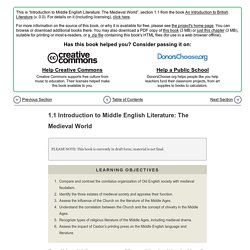
In medieval Britain, “the Church” referred to the Roman Catholic Church. Canterbury Cathedral. Medieval Literature. Facts and interesting information about Medieval Life,specifically, Medieval Literature Medieval Literature - The Dark Ages and the BardsEnglish Medieval literature had, so far as we know, no existence until Christian times of the Dark Ages when Latin was the language of English literature.
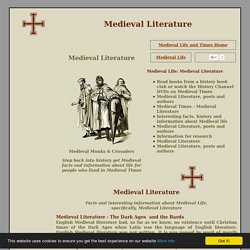
English Medieval literature was not written. It is was passed by word of mouth from one generation to another by English, Welsh and Irish bards. The history of the Great Britain: THE CONTRIBUTION OF WILLIAM, THE CONQUEROR TO THE DEVELOPMENT OF THE BRITISH SOCIETY. William, the illegitimate son of the Duke of Normandy, spent his first six years with his mother and received the duchy of upon his father's death in council consisting of noblemen and William's appointed guardians ruled but ducal authority became weaker under the ’ violent nature and the province was wracked with assassination and revolt for twelve years.

In 1047, William reasserted himself in the eastern Norman regions and, with the aid of ’s King Henry I, crushed the rebelling barons. He spent the next several years consolidating his strength on the continent through marriage, diplomacy, war and savage intimidation. By 1066, was in a position of virtual independence from William’s feudal lord; Henry I of and the disputed succession in offered William an opportunity for invasion. Medieval%20people.pdf. Medieval Colonialism: Postcrusade Exploitation of Islamic Valencia - Robert Ignatius Burns.
What does a Bailiff do? What is a Bailiff?
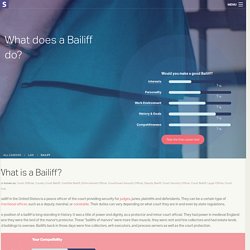
Also known as: Court Official, County Court Bailiff, Certified Bailiff, Enforcement Officer, Courthouse Security Officer, Deputy Bailiff, Court Security Officer, Court Bailiff, Legal Officer, Court Officer. A bailiff in the United States is a peace officer of the court providing security for judges, juries, plaintiffs and defendants. They can be a certain type of correctional officer, such as a deputy, marshal, or constable. Their duties can vary depending on what court they are in and even by state regulations. The position of a bailiff is long-standing in history. Find your compatibility Would you make a good bailiff? Reeve (England) Originally in Anglo-Saxon England the reeve was a senior official with local responsibilities under the Crown e.g. as the chief magistrate of a town or district.
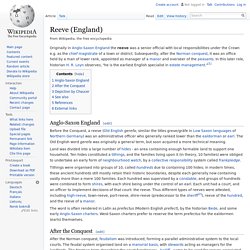
Subsequently, after the Norman conquest, it was an office held by a man of lower rank, appointed as manager of a manor and overseer of the peasants. In this later role, historian H. R. Royal touch. Origins[edit] A 15th-century manuscript depicting the tradition that Clovis I healed the scrofulous following his coronation.

The kings and queens regnant of England and the kings of France were the only Christian rulers who claimed the divine gift (divinitus)[4] to cure by touching or stroking the diseased.[2] This special aptitude was thought to be evidence of God's high esteem of the two monarchies, though they never agreed upon whose predecessors the ability was first conferred. In England, Saint Edward the Confessor (r. 1042–1066) was said to be the first monarch to possess the healing power of the royal touch.[2] The French, who normally traced the origins of their monarchs' divine gift back to Philip I (r. 1059–1108) or even Robert II (r. 987–1031), denied that Saint Edward used the royal touch.
England[edit] Henry I's successors did not consider the royal touch fundamental, reducing its application. Procedure[edit] Frequency[edit] Bloodletting. Ancient Greek painting on a vase, showing a physician (iatros) bleeding a patient Bloodletting (or blood-letting) is the withdrawal of blood from a patient to cure or prevent illness and disease.
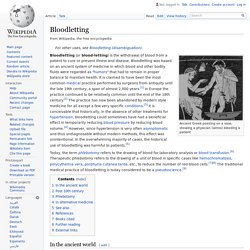
Bloodletting was based on an ancient system of medicine in which blood and other bodily fluids were regarded as "humors" that had to remain in proper balance to maintain health. In the ancient world[edit] A chart showing the parts of the body to be bled for different diseases, c.1310-1320 "Bleeding" a patient to health was modeled on the process of menstruation. Medicine in the Middle Ages. Medical knowledge in the Middle Ages must have appeared to have stood still. While the Ancient Romans,Greeks and Egyptians had pushed forward medical knowledge, after the demise of these civilisations, the momentum started by these people tended to stagnate and it did not develop at the same pace until the Seventeenth/Eighteenth Centuries. In Britain, as an example, most things linked to the Romans was destroyed – villas were covered up as the Ancient Britons believed that they contained ghosts and evil spirits.
With this approach, it is not surprising that anything medical linked to the Romans fell into disuse in Britain. By the 14th Century, universities had developed in Western Europe that could be classed as medical schools where students could study under a master physician. 10 Bizarre Medieval Medical Practices. Creepy Medicine is one of the cornerstones of modern civilization—so much so that we take it for granted.
It wasn’t always the case that you could just waltz into a doctor’s office to have them cure what ailed you. In medieval times, for example, things were a lot more dangerous, and a lot stranger. 10 Boar Bile Enemas Enemas in medieval times were performed by devices called clysters. Even kings were high up on the clyster. 9 Urine Was Used As An Antiseptic Though it may not have been common, there is evidence to suggest that urine was occasionally used as an antiseptic in the Medieval Era. This isn’t quite as insane as it seems: urine is sterile when it leaves the body and may have been a healthier alternative than most water—which came with no such guarantee of cleanliness. 8 Eye Surgery (With A Needle) During the Middle Ages, cataract surgery was performed with a thick needle.
10 Completely Uncanny Superstitions From The Middle Ages. Weird Stuff In the pre-scientific Middle Ages, the world was at the same time both fascinating and frightening. In the absence of proper knowledge, people had no choice but to fall back on their own imaginations to make sense of the myriad natural phenomena around them. Events & Eras. William the Conqueror Biography. The Normans. The Normans and the Battle of Hastings for Kids. Medieval England. Timeline of Medieval Britain.